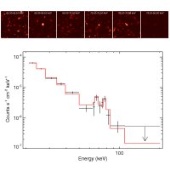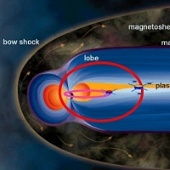ESA Science & Technology - Science Results
Science Results
Science Results
In a dedicated survey, the Hubble Space Telescope has discovered 16 extrasolar planet candidates orbiting a variety of distant stars in our Galaxy, and among these a new class of planets is discovered with an extremely short orbital period.
Published: 4 October 2006
Detailed simultaneous observations by the Cluster spacecraft and the TC-1 Double Star satellite, reveal new characteristics of reconnection sites at the Earth's magnetopause.
Published: 3 October 2006
Published: 3 October 2006
A recent article in the Astrophysical Journal by Renaud et al. presents the results of detailed spectroimaging of the young Cassiopeia A supernova remnant with INTEGRAL IBIS/ISGRI that constrain the 44Ti signature and production models.
Published: 29 September 2006
Astronomers analyzing two of the deepest views of the cosmos have uncovered a gold mine of galaxies, more than 500 that existed less than a billion years after the Big Bang.
Published: 22 September 2006
Astronomers using the NASA/ESA Hubble Space Telescope have photographed one of the smallest objects ever seen around a normal star beyond our Sun.
Published: 7 September 2006
The SMART-1 observation campaign latest results bring new evidences on SMART-1 impact: timing, location, detection of flash and ejecta, and a firework.
Published: 7 September 2006
In a press conference, held at ESOC on 4 September, the key outcomes of the SMART-1 mission from an operational, technical and scientific perspective were presented. In addition the latest results from the mission were also revealed.
Published: 4 September 2006
At 05h42m21.759s UT, 3 September, a small flash illuminated the surface of the Moon as the European Space Agency's SMART-1 spacecraft impacted onto the lunar soil in Lacus Excellentiae.
Published: 3 September 2006
Results from two recent flybys of Titan, by the Cassini spacecraft, have added to the evidence suggesting that hydrocarbon lakes exist on its surface.
Published: 25 July 2006
Published in the July edition of Nature Physics, an international team led by Chinese scientists report the observational first by Cluster of the key region at the heart of the magnetic reconnection process in 3D.
Published: 18 July 2006
Presented in a recent paper by George Parks et al, unique observations of the combined Cluster and Double Star TC-1 spacecraft have revealed a new phenomenon of density holes in the solar wind, thousands of kilometres across.
Published: 20 June 2006
Published: 20 June 2006
Presented in a recent paper a team of astronomers led by R. Marcinkowski have shown INTEGRAL's capability to observe powerful Gamma-Ray Bursts that are located outside the telescope's field of view. The high energy radiation can pass through the lead shielding and onto the detectors. After analysis, the collected data can reveal the position on...
Published: 19 June 2006
AKARI, the new Japanese infrared sky surveyor mission in which ESA is participating, saw first light on 13 April 2006 (UT). The first images were taken towards the end of a successful checkout of the spacecraft in orbit and show the enormous improvement in sensitivity and resolution compared to the IRAS satellite.
Published: 22 May 2006
In an article based on multi-point observations from the Cluster spacecraft, a team led by Forrest Mozer reveals new insights into the processes at the core of the magnetic reconnection phenomenon.
Published: 19 May 2006
Deep observations of two X-ray bright galaxy clusters by XMM-Newton, have provided detailed information on the chemical composition of the hot intra-cluster medium and the difference in the evolution of these two clusters.
Published: 11 May 2006
The NASA/ESA Hubble Space Telescope is providing astronomers with extraordinary views of comet 73P/Schwassmann-Wachmann 3 as it disintegrates before our eyes.
Published: 27 April 2006
Scientists have released the first ever images of the Venusian south pole. Venus Express captured the images on 12 April from a distance of 200 000 km following its successful orbit insertion manoeuvre.
Published: 13 April 2006
Published 8 November 2005 in Annales Geophysicae, an article by Zhang et al. presents the first ever simultaneous observation of neutral sheet oscillations, giving a more global view of this phenomenon than previously possible.
Published: 30 March 2006
—
20 Items per Page

















